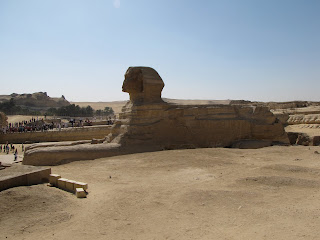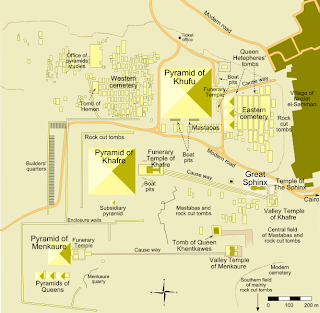
The Great Sphinx in front of the Pyramid of Khafre
There they stood—the Pyramids of Giza—right in front of us and guarded by the Great Sphinx. After learning about them in school, reading about them in books, and watching them on TV it was hard to believe I was experiencing them in person. It was also slightly confusing. In photographs and through the world of media they always appear to rise out of the desert—alone in the vastness of sand and heat only to be visited by Bedouins on camelback. But in reality, they sit within an uncomfortably close proximity to modern Cairo. Hop out of your taxi and walk a few meters to the base of the Sphinx. Shop in the market and catch a glimpse of the towering Ancient Wonders between shops. Or, even better, marvel at the trio from the comfort of an air-conditioned table inside Pizza Hut—the best indoor view of the pyramids in town.
What... have... we (modern people)... done?
The Giza Necropolis comprises several monuments including the three Great Pyramids, the Great Sphinx, a handful of queens' tombs, funerary temples, and the cemeteries for the skilled laborers (although the Greeks still maintain that the pyramids were built by slaves, modern-day Egyptologists agree skilled laborers were hired for the immense job). The oldest and largest pyramid, known as the Great Pyramid, was built for fourth dynasty Egyptian Pharaoh Khufu. Completed around 2551 BC, its base is almost perfectly square and level. Originally 146 meters tall, it was the tallest structure in the world for over 3,800 years until the 160-meter-tall spire of Lincoln Cathedral in Lincolnshire, England popped up.
The Pyramid of Khafre is the second largest in the necropolis and the tomb of Khufu's son. Its steep slope and elevated base enhance the illusion of its size and impressiveness, but the pyramid still ranks as number two. Unlike Khafre, Khufu does not cheat.
The third, and smallest, of the three pyramids belonged to Menkaure. Allegedly much more benevolent than his predecessors, the Pharaoh's pyramid acts as the understated underdog. In the twelfth century Malek Abd al-Aziz Othman ben Yusuf attempted to demolish the three pyramids beginning with Menkaure's tomb. He and his friends worked for eight months at removing the gargantuan stones but only successfully took down one or two per day. Realizing their attempts were futile and expensive, they abandoned the idea and left the pyramid with a large vertical gash in its side. Way to go.
Reclining in front of Khafre's pyramid is the largest monolith statue in the world and the oldest monumental sculpture—the Great Sphinx. Having the head of a man and the body of a lion, some speculate it was created by Khafre in his image. However, exactly when it was built, who built it, and who it depicts round out the mysteries of the "Riddle of the Sphinx."
Before waving goodbye to the necropolis, we had the opportunity to descend inside one of the queens' pyramids. The tiny opening required a reduction in height and we walked down the narrow ramp doubled over. At the end of the tunnel we emptied into a small, stifling room—once the location of the sarcophagus. The temperature soared beyond uncomfortable and as people continued to file in we decided to make our escape. When we finally returned to the surface, the sun's rays felt cool in comparison to the thick heat inside the pyramid and I thought a cold soda from Pizza Hut didn't sound so bad.


From left to right: Pyramid of Menkaure, Pyramid of Khafre, Pyramid of Khufu (The Great Pyramid).

In front of the Pyramid of Khafre

Sitting on the Pyramid of Khufu (The Great Pyramid)

.svg.png)

0 comments:
Post a Comment